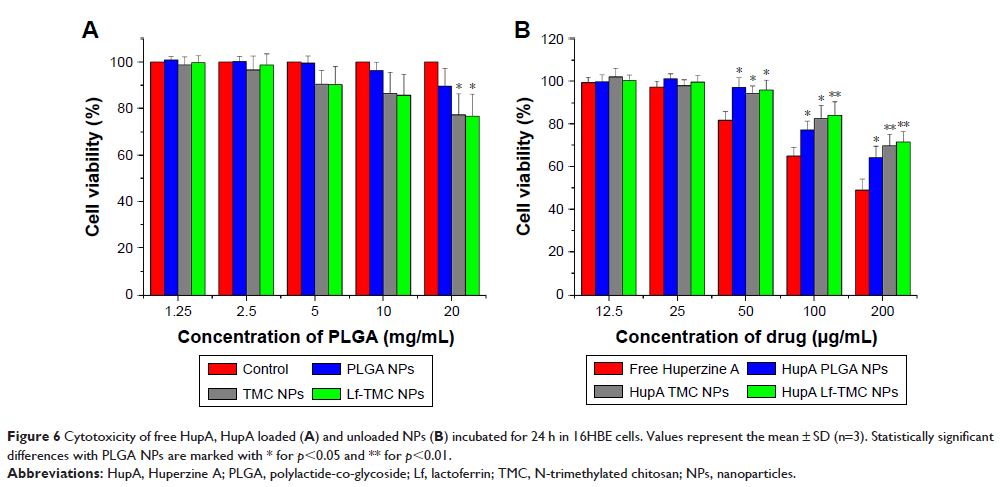108985
论文已发表
注册即可获取德孚的最新动态
IF 收录期刊
- 3.4 Breast Cancer (Dove Med Press)
- 3.2 Clin Epidemiol
- 2.6 Cancer Manag Res
- 2.9 Infect Drug Resist
- 3.7 Clin Interv Aging
- 5.1 Drug Des Dev Ther
- 3.1 Int J Chronic Obstr
- 6.6 Int J Nanomed
- 2.6 Int J Women's Health
- 2.9 Neuropsych Dis Treat
- 2.8 OncoTargets Ther
- 2.0 Patient Prefer Adher
- 2.2 Ther Clin Risk Manag
- 2.5 J Pain Res
- 3.0 Diabet Metab Synd Ob
- 3.2 Psychol Res Behav Ma
- 3.4 Nat Sci Sleep
- 1.8 Pharmgenomics Pers Med
- 2.0 Risk Manag Healthc Policy
- 4.1 J Inflamm Res
- 2.0 Int J Gen Med
- 3.4 J Hepatocell Carcinoma
- 3.0 J Asthma Allergy
- 2.2 Clin Cosmet Investig Dermatol
- 2.4 J Multidiscip Healthc

已发表论文
使用乳铁蛋白偶联的 N-三甲基化壳聚糖表面修饰的 PLGA 纳米粒子进行石杉碱甲至大脑的鼻内递送以治疗阿尔茨海默病
Authors Meng QQ, Wang AP, Hua HC, Jiang Y, Wang YY, Mu HJ, Wu ZM, Sun KX
Received 12 September 2017
Accepted for publication 11 December 2017
Published 1 February 2018 Volume 2018:13 Pages 705—718
DOI https://doi.org/10.2147/IJN.S151474
Checked for plagiarism Yes
Review by Single-blind
Peer reviewers approved by Dr Govarthanan Muthusamy
Peer reviewer comments 2
Editor who approved publication: Dr Lei Yang
Background: Safe and
effective delivery of therapeutic drugs to the brain is important for
successful therapy of Alzheimer’s disease (AD).
Purpose: To develop Huperzine A (HupA)-loaded, mucoadhesive and targeted polylactide-co-glycoside (PLGA) nanoparticles (NPs) with surface modification by lactoferrin (Lf)-conjugated N-trimethylated chitosan (TMC) (HupA Lf-TMC NPs) for efficient intranasal delivery of HupA to the brain for AD treatment.
Methods: HupA Lf-TMC NPs were prepared using the emulsion–solvent evaporation method and optimized using the Box–Behnken design. The particle size, zeta potential, drug entrapment efficiency, adhesion and in vitro release behavior were investigated. The cellular uptake was investigated by fluorescence microscopy and flow cytometry. MTT assay was used to evaluate the cytotoxicity of the NPs. In vivo imaging system was used to investigate brain targeting effect of NPs after intranasal administration. The biodistribution of Hup-A NPs after intranasal administration was determined by liquid chromatography–tandem mass spectrometry.
Results: Optimized HupA Lf-TMC NPs had a particle size of 153.2±13.7 nm, polydispersity index of 0.229±0.078, zeta potential of +35.6±5.2 mV, drug entrapment efficiency of 73.8%±5.7%, and sustained release in vitro over a 48 h period. Adsorption of mucin onto Lf-TMC NPs was 86.9%±1.8%, which was significantly higher than that onto PLGA NPs (32.1%±2.5%). HupA Lf-TMC NPs showed lower toxicity in the 16HBE cell line compared with HupA solution. Qualitative and quantitative cellular uptake experiments indicated that accumulation of Lf-TMC NPs was higher than nontargeted analogs in 16HBE and SH-SY5Y cells. In vivo imaging results showed that Lf-TMC NPs exhibited a higher fluorescence intensity in the brain and a longer residence time than nontargeted NPs. After intranasal administration, Lf-TMC NPs facilitated the distribution of HupA in the brain, and the values of the drug targeting index in the mouse olfactory bulb, cerebrum (with hippocampus removal), cerebellum, and hippocampus were about 2.0, 1.6, 1.9, and 1.9, respectively.
Conclusion: Lf-TMC NPs have good sustained-release effect, adhesion and targeting ability, and have a broad application prospect as a nasal drug delivery carrier.
Keywords: Huperzine A, lactoferrin, N -trimethyl chitosan, nose-to-brain, nanoparticles, Alzheimer’s disease
Purpose: To develop Huperzine A (HupA)-loaded, mucoadhesive and targeted polylactide-co-glycoside (PLGA) nanoparticles (NPs) with surface modification by lactoferrin (Lf)-conjugated N-trimethylated chitosan (TMC) (HupA Lf-TMC NPs) for efficient intranasal delivery of HupA to the brain for AD treatment.
Methods: HupA Lf-TMC NPs were prepared using the emulsion–solvent evaporation method and optimized using the Box–Behnken design. The particle size, zeta potential, drug entrapment efficiency, adhesion and in vitro release behavior were investigated. The cellular uptake was investigated by fluorescence microscopy and flow cytometry. MTT assay was used to evaluate the cytotoxicity of the NPs. In vivo imaging system was used to investigate brain targeting effect of NPs after intranasal administration. The biodistribution of Hup-A NPs after intranasal administration was determined by liquid chromatography–tandem mass spectrometry.
Results: Optimized HupA Lf-TMC NPs had a particle size of 153.2±13.7 nm, polydispersity index of 0.229±0.078, zeta potential of +35.6±5.2 mV, drug entrapment efficiency of 73.8%±5.7%, and sustained release in vitro over a 48 h period. Adsorption of mucin onto Lf-TMC NPs was 86.9%±1.8%, which was significantly higher than that onto PLGA NPs (32.1%±2.5%). HupA Lf-TMC NPs showed lower toxicity in the 16HBE cell line compared with HupA solution. Qualitative and quantitative cellular uptake experiments indicated that accumulation of Lf-TMC NPs was higher than nontargeted analogs in 16HBE and SH-SY5Y cells. In vivo imaging results showed that Lf-TMC NPs exhibited a higher fluorescence intensity in the brain and a longer residence time than nontargeted NPs. After intranasal administration, Lf-TMC NPs facilitated the distribution of HupA in the brain, and the values of the drug targeting index in the mouse olfactory bulb, cerebrum (with hippocampus removal), cerebellum, and hippocampus were about 2.0, 1.6, 1.9, and 1.9, respectively.
Conclusion: Lf-TMC NPs have good sustained-release effect, adhesion and targeting ability, and have a broad application prospect as a nasal drug delivery carrier.
Keywords: Huperzine A, lactoferrin, N -trimethyl chitosan, nose-to-brain, nanoparticles, Alzheimer’s disease
